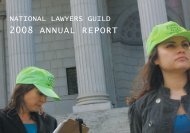The Assault on Free Speech, Public Assembly, and Dissent
The Assault on Free Speech, Public Assembly, and Dissent
The Assault on Free Speech, Public Assembly, and Dissent
Create successful ePaper yourself
Turn your PDF publications into a flip-book with our unique Google optimized e-Paper software.
A Nati<strong>on</strong>al Lawyers Guild Report 15<br />
of Justice entered into in 1999 amid allegati<strong>on</strong>s that police were<br />
engaging in racial profiling. A U.S. District Judge signed an order in<br />
early April 2004 ending federal oversight of the Office of<br />
Professi<strong>on</strong>al St<strong>and</strong>ards, the internal affairs unit of the New Jersey<br />
police. Civil-rights leaders were critical of the judge’s decisi<strong>on</strong>,<br />
saying that the c<strong>on</strong>sent decree should not be lifted in pieces.<br />
Mr. Ashcroft publicly indicated his reluctance to use the law to<br />
prosecute police departments in his remarks to the Fraternal Order of<br />
Police in its 55th Biennial Nati<strong>on</strong>al C<strong>on</strong>ference in Phoenix <strong>on</strong><br />
August 14, 2001. In explaining how in 1999 the District of Columbia<br />
Metropolitan Police Department “asked for help to determine if its<br />
officers used excessive force in dealing with members of the public,”<br />
he described how the Justice Department began to “fix the problem:”<br />
No court orders were involved. No c<strong>on</strong>sent decrees<br />
were issued. Through hard work <strong>and</strong> good will <strong>on</strong><br />
both sides we were able to produce results. 24<br />
C<strong>on</strong>sent decrees are generally regarded as critical in implementing<br />
instituti<strong>on</strong>al reform in police departments. Former U.S. Assistant<br />
Attorney General John Dunne has noted that c<strong>on</strong>sent decrees force<br />
top-level police officials to commit to reform. 25 He also supports<br />
bringing pattern-<strong>and</strong>-practice suits <strong>and</strong> says they cast “a whole new<br />
light <strong>on</strong> the matter of Civil Rights Divisi<strong>on</strong> resp<strong>on</strong>sibility.” 26 Indeed,<br />
Mr. Ashcroft’s “hard work <strong>and</strong> good will” approach clearly had no<br />
l<strong>on</strong>g-term effect <strong>on</strong> the MPD’s pattern <strong>and</strong> practice of using<br />
excessive force against members of the public, as a 2004 report by<br />
the D.C. City Council’s Committee <strong>on</strong> the Judiciary explains in<br />
detail. 27<br />
By not exercising federal prosecutorial oversight of nati<strong>on</strong>al,<br />
systemic police violati<strong>on</strong>s of civil rights, Attorney General Ashcroft<br />
is essentially acting as a c<strong>on</strong>spirator with police departments around<br />
the nati<strong>on</strong> to deprive people of their c<strong>on</strong>stituti<strong>on</strong>ally protected rights.<br />
Ashcroft could, for example, bring pattern-<strong>and</strong>-practice suits under<br />
the Federal Civil Rights Act, 42 USC Secti<strong>on</strong>s 1981-1988, especially<br />
Secti<strong>on</strong> 1983 (the Civil Rights Act of 1871). <str<strong>on</strong>g>The</str<strong>on</strong>g> Supreme Court<br />
identified the three primary purposes intended by the C<strong>on</strong>gress that<br />
enacted the statute: 1) to override certain kinds of state laws; 2) to<br />
provide a remedy where state law was inadequate; <strong>and</strong> 3) to provide<br />
a federal remedy where the state remedy, though adequate in theory,<br />
was not available in practice. 28


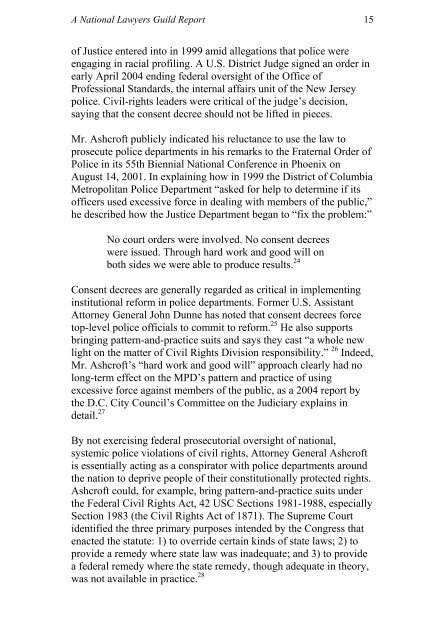
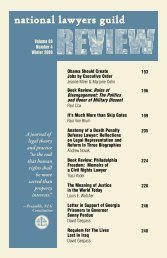
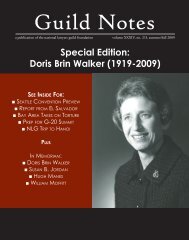
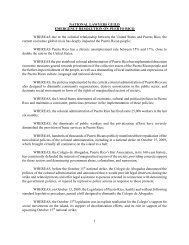
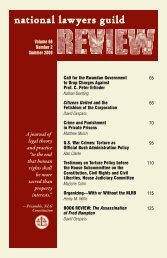
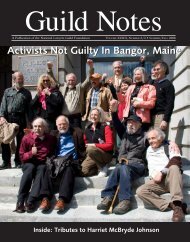
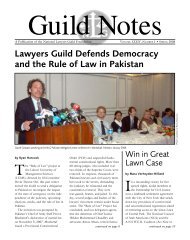
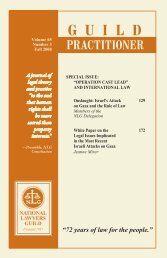

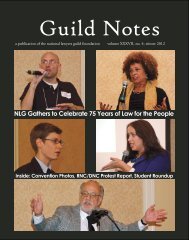

![NLGRev 68-2[1].indd - National Lawyers Guild](https://img.yumpu.com/30820772/1/167x260/nlgrev-68-21indd-national-lawyers-guild.jpg?quality=85)

